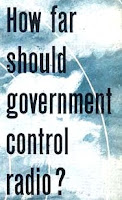
This "decision" was made based on studies done by NAB (National Association of Broadcasters) and a second study conducted by the FCC's own Office of Engineering and Technology. The FCC opened up some filing windows and allowed applications without the third adjacent channel protection. The protection is so bogus even the EMF agrees, letter here.
It's safe to say NAB opposes LPFM service in general. And also that it used it's mighty lobbying power to get Congress to pass a bill that imposed third adjacent channel protections to both full power and FM translators. It also banned former pirate broadcasters from geting an LPFM license. Hundreds of LPFM applications were voided. They also ran adverts to buttress their cause and muddy the water. Thankfully their href="http://www.beatworld.com/images/adlie101500.gif">propaganda was retarded and transparent.
The Radio Broadcast Protection Act was passed and eventually codified in the FCC rules. The FCC then had a short remedial filing window where those impacted by the RBPA could file a major change application to move their station to a different location and/or channel. Some stations filed applications while others were deadlocked. Those who were deadlocked were dismissed on March 17, 2003, a day we call the "St. Patty's Day Massacre".
codified in the FCC rules. The FCC then had a short remedial filing window where those impacted by the RBPA could file a major change application to move their station to a different location and/or channel. Some stations filed applications while others were deadlocked. Those who were deadlocked were dismissed on March 17, 2003, a day we call the "St. Patty's Day Massacre".
RELATED READING: The infamous Mitre report that exposed the bogus protection.
the http://www.recnet.com/mitre/2.pdf
It's safe to say NAB opposes LPFM service in general. And also that it used it's mighty lobbying power to get Congress to pass a bill that imposed third adjacent channel protections to both full power and FM translators. It also banned former pirate broadcasters from geting an LPFM license. Hundreds of LPFM applications were voided. They also ran adverts to buttress their cause and muddy the water. Thankfully their href="http://www.beatworld.com/images/adlie101500.gif">propaganda was retarded and transparent.
The Radio Broadcast Protection Act was passed and eventually
 codified in the FCC rules. The FCC then had a short remedial filing window where those impacted by the RBPA could file a major change application to move their station to a different location and/or channel. Some stations filed applications while others were deadlocked. Those who were deadlocked were dismissed on March 17, 2003, a day we call the "St. Patty's Day Massacre".
codified in the FCC rules. The FCC then had a short remedial filing window where those impacted by the RBPA could file a major change application to move their station to a different location and/or channel. Some stations filed applications while others were deadlocked. Those who were deadlocked were dismissed on March 17, 2003, a day we call the "St. Patty's Day Massacre".RELATED READING: The infamous Mitre report that exposed the bogus protection.
the http://www.recnet.com/mitre/2.pdf




No comments:
Post a Comment